automotive design
2020 Mitsubishi ASX Exceed: Private Fleet Car Review.
 This Car Review Is About: A recently (late 2019) updated ASX range which received the Mitsubishi shield nose, a mild refresh to the tail light cluster, and the deletion of a diesel as an option.
This Car Review Is About: A recently (late 2019) updated ASX range which received the Mitsubishi shield nose, a mild refresh to the tail light cluster, and the deletion of a diesel as an option.
The Exceed sits at the top of a six tier (ES is manual or auto) range which provides one of the broadest choices available to Australian consumers for one stand-alone model.
How Much Does It Cost?: Mitsubishi have tight pricing for a diverse range. The entry point is the ES which lists at $24,990 drive-away as of February 2020. The Exceed comes in at $35,990. For that price Mitsubishi are including seven years warranty and two years free servicing. Under The Bonnet Is: Mitsubishi’s well proven 2.4L MIVEC petrol fed engine. There are no diesels and, as yet, no hybrids. Only the ES has a manual option, with a CVT being the transmission of no choice. It’s not a winner but more on that later. Peak power is 124kW, with peak twist of 222 torques available at 4,100rpm. Economy was excellent, with an around town best of a paltry 6.3L/100km. Mitsubishi’s combined figure is quoted as 7.9L/100km from a 63L tank filled with standard 91RON unleaded. Drive is now to the front wheels only.
Under The Bonnet Is: Mitsubishi’s well proven 2.4L MIVEC petrol fed engine. There are no diesels and, as yet, no hybrids. Only the ES has a manual option, with a CVT being the transmission of no choice. It’s not a winner but more on that later. Peak power is 124kW, with peak twist of 222 torques available at 4,100rpm. Economy was excellent, with an around town best of a paltry 6.3L/100km. Mitsubishi’s combined figure is quoted as 7.9L/100km from a 63L tank filled with standard 91RON unleaded. Drive is now to the front wheels only.
On The Outside It’s: Lost the dumpy, squat, short jawed look and gained an assertive stance thanks to the reworked front. Apart from being resized and re-proportioned to fit the ASX, it’s identical to that seen on the rest of the family. The lower corners have a quad “ice cube” cluster with fog and indicator LEDs. With that sharper front end, it also highlights the curves in the rear which now don’t quite match the other end.
Both front fenders have a black plastic insert ringed with chrome. These sit on the join line with the doors and draw an upwards incline through the door handles to the rear window. The tailgate is manually operated, a feature that Mitsubishi should have sprung for to change to powered.
Tyres are from Bridgestone and their Ecopia range. They’re 225/55/17 and are on distinctive ten spoke alloys with black paint. The sheetmetal has a choice of eight colours, with the review vehicle in Lightning Blue. On The Inside It’s: Starting to show the base design’s age. Flat and slabby are how to describe the dashboard. Only the seats could be described as soft touch, and they’re sat on, not in. Again, the front seats are heated only, an oversight that doesn’t suit Australian summers.
On The Inside It’s: Starting to show the base design’s age. Flat and slabby are how to describe the dashboard. Only the seats could be described as soft touch, and they’re sat on, not in. Again, the front seats are heated only, an oversight that doesn’t suit Australian summers. The driver faces a traditional two dial display with Mitsubishi’s standard colour LCD screen in between. For the Exceed, at least, a full LCD screen for a little class difference should be here.
The driver faces a traditional two dial display with Mitsubishi’s standard colour LCD screen in between. For the Exceed, at least, a full LCD screen for a little class difference should be here.
The driver’s seat is powered for adjustment, at least. The second row fold easily and offer over 1,100 litres of cargo space. It’s here that you’ll find the subwoofer driver for the Rockford Fosgate DAB audio system. The company is a long time supplier of audio to Mitsubishi and it shows. It’s beautifully integrated and provides a sensational kick from the sub, balanced by outstanding treble and mid-range notes. The touchscreen is an 8.0 inch unit and the interface has been redesigned for a better look and use. Naturally it’s Android, Apple, and Bluetooth compatible in regards to the sounds system.
 Piano black surrounds the screen, as it does the gear selector and portions of the steering wheel. Auto wipers and headlights are standard also. The aircon is single zone and a pair of USB ports sit below the knurled chrome dials. The centre console houses two cupholders close to the console storage locker.
Piano black surrounds the screen, as it does the gear selector and portions of the steering wheel. Auto wipers and headlights are standard also. The aircon is single zone and a pair of USB ports sit below the knurled chrome dials. The centre console houses two cupholders close to the console storage locker.
For a vehicle that fringes the small and medium SUV class, at just 4,365mm in length, it’s well packaged inside for head, shoulder, and leg room. Up front is 1,056mm with the rear seats having 921mm. Headroom is fine considering the ASX Exceed has a full glass roof. Front and rear measurements are 988mm and 934mm.
On The Road It’s: Frankly disappointing. The CVT hobbled the 2.4L to the point Sports mode was the preferred choice for driving. Sports mode should a mode to complement the normal Drive, not be the preferred standard. The Low range gear option made its presence appreciated when hitting the upwards slopes in Sydney’s Blue Mountains too, utilising the 222Nm far more efficiently than standard Drive. Left in Drive, acceleration was akin to wading knee deep in molasses whilst wearing boots and jeans. An Apollo trip to the moon and back is quicker than the ASX Exceeds time to 100. Flip the gear selector to the left and the chains are broken, the molasses is gone, and Apollo is still on the launch pad, such is the startling difference in nature. It also makes for a decent highway cruiser, quietly bubbling along and showing no signs of struggle. Corners, though….there’s little body roll but hit a road joint, an expansion joint, and suddenly the words lateral stability disappear. The front and/or rear skip violently sideways and for the unaware, it’s a moment of wondering what could happen.
Left in Drive, acceleration was akin to wading knee deep in molasses whilst wearing boots and jeans. An Apollo trip to the moon and back is quicker than the ASX Exceeds time to 100. Flip the gear selector to the left and the chains are broken, the molasses is gone, and Apollo is still on the launch pad, such is the startling difference in nature. It also makes for a decent highway cruiser, quietly bubbling along and showing no signs of struggle. Corners, though….there’s little body roll but hit a road joint, an expansion joint, and suddenly the words lateral stability disappear. The front and/or rear skip violently sideways and for the unaware, it’s a moment of wondering what could happen. Braking and steering are suitable for the ASX Exceed too. There’s enough pedal pressure to tell the driver what’s going on in the stopping department whilst the steering, as light as it is, doesn’t feel artificial or over assisted.
Braking and steering are suitable for the ASX Exceed too. There’s enough pedal pressure to tell the driver what’s going on in the stopping department whilst the steering, as light as it is, doesn’t feel artificial or over assisted.
Ride quality is also on par for expectations. It’s well tied down, finding that fine balance between absorption, suppleness, and tautness. Freeway driving has the steering requiring just the right amount of minimal input required.
What About Safety?: No problems here. Forward Collision Mitigation starts the list, Blind Spot Alert, Rear Cross Traffic Alert, and Lane Change Assist are here, along with seven airbags including driver’s knee. Front seat seatbelt pretensioners and a pair of ISOFIX seat mounts in the rear seats are also standard. A reverse camera with guidelines and rear sensors add to the package.
At The End Of the Drive. In our opinion, as much of a difference the facelift has made, it’s still, essentially, the same decade old ASX inside and it shows. It’s a massive seller for Mitsubishi, it’s fair to say, and that’s due to some very good pricing and the less than discerning tastes for a quality drive from those buyers. Given that there are similar vehicles at not much more that have a better interior and are dynamically superior, Mitsubishi should be giving thought to an improvement underneath from here on in. Find out more here.
Subaru Unveils Updated Impreza and Hybridised XV & Forester.
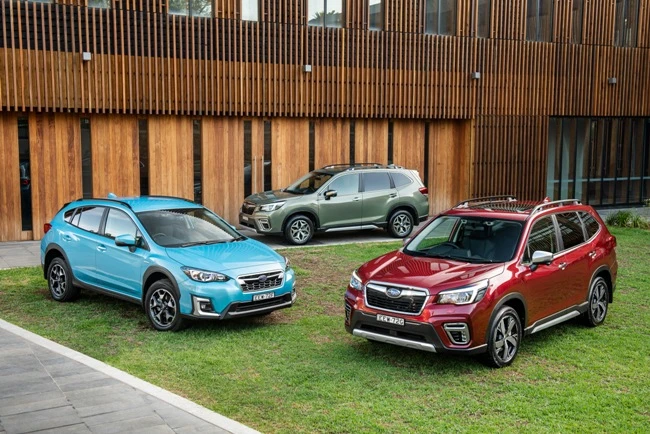
Niche filler Subaru has finally joined the hybrid family. The XV hatch and Forester now have that propulsion as an option. They’ve also updated their Impreza sedan and hatch range. For the XV there will be one variant and in hybrid form only, whilst the Forester will offer two, in L and S AWD specification.
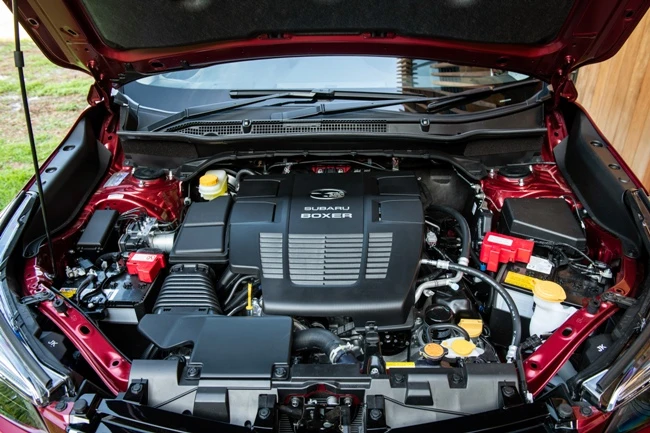
Forester will run the familiar 2.0L horizontally opposed four, as will the XV. Transmission remains as Subaru’s quite well sorted CVT. The Hybrid system has been dubbed “e-Boxer”, with a small capacity lithium battery linked to the petrol engine in a method called Motor Assist. There will be three drive modes available: Motor Assist EV driving, Motor Assist electric (EV) + petrol engine driving, and Petrol engine driving.
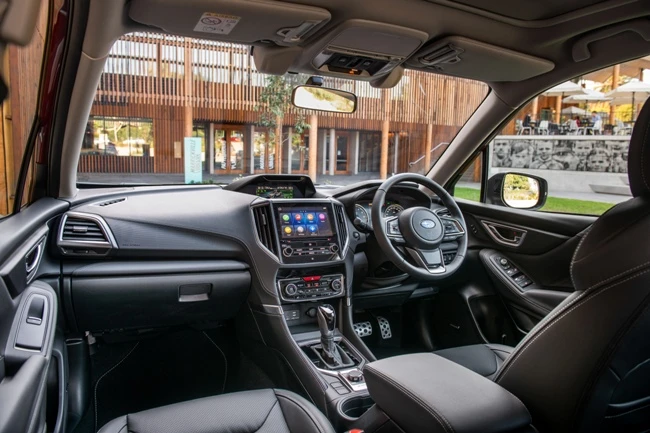
In pure EV mode it can reach speeds of up to 40 km/h before switching in the petrol engine. Economy, says Subaru, is down to 6.7L/100 from the 48L tank. Fuel is 91RON. That’s down from 8.1L/100km. XV Hybrid has an improvement of around 14% improvement for the urban cycle, and upwards of 7% for the combined. Forester’s improvements are 19% and 9% compared to the previous 2.5L variants.
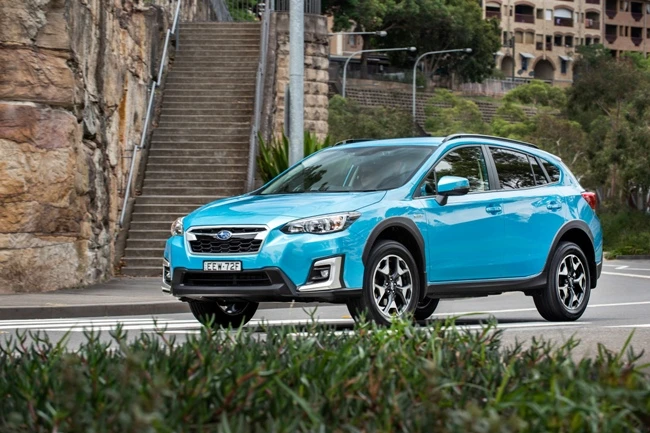
Power is rated as 110 Kilowatts at 6,000 rpm and 196 Nm of torque at 4,000 rpm with the electric energy part offering 12.3kW and 66Nm or torque. Naturally the electric system features regenerative braking energy harvesting. The battery is integrated into the floor and located where the spare wheel once resided. The petrol engine has Subaru’s AVCS, or Active Valve Control System. Pricing for the trio is: $35,580 for XV Hybrid AWD, $39,990 for Forester Hybrid L AWD and $45,990 for the Hybrid S. Those prices are manufacturer’s list prices.
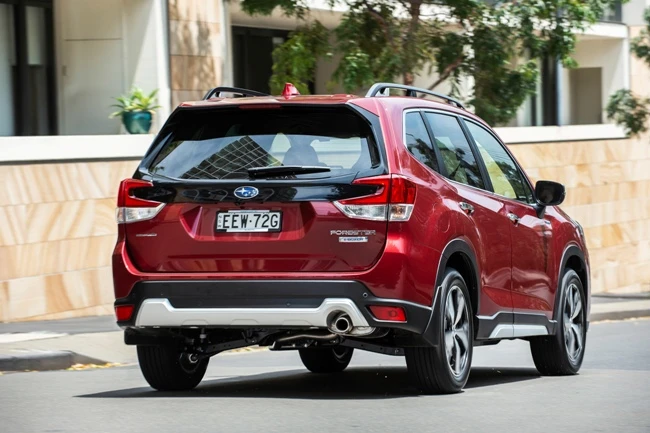
Subaru’s X-Mode, for soft and wet weather road driving, has returned. This is again a switch operated drive mode, and will show on the driver displays to indicate its engagement. Forester Hybrid S also has Subaru’s SI Drive system, where different driving modes, Intelligent and Sport, allow for some driver tailoring. The touchscreen is 6.5 inches in L, 8.0 inches in S, and features DAB, Apple and Android apps, driver’s kneebag, and Subaru’s renowned EyeSight system.
Orders are being taken however the initial allocation has been presold, with May the current ETA for new stock.
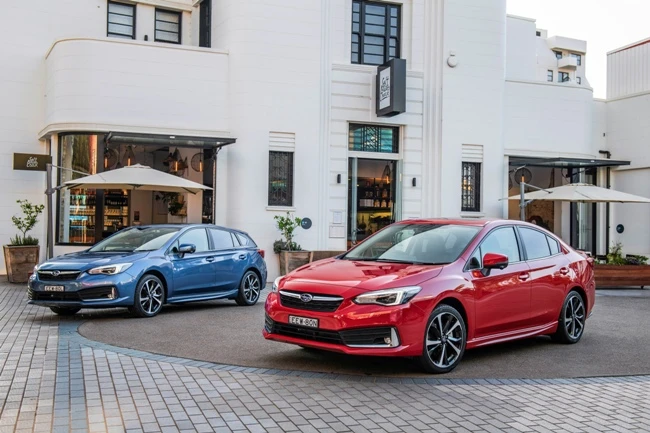
The bodies for both have been slightly tweaked, as has the Impreza sedan and hatch. All models have been given a restyled grille, with the front bumper and fog lights changed as well, plus there are new alloy wheels. The tail lights for the hatch have been given a smokey glass appearance. Also, all Imprezas now have SI Drive.
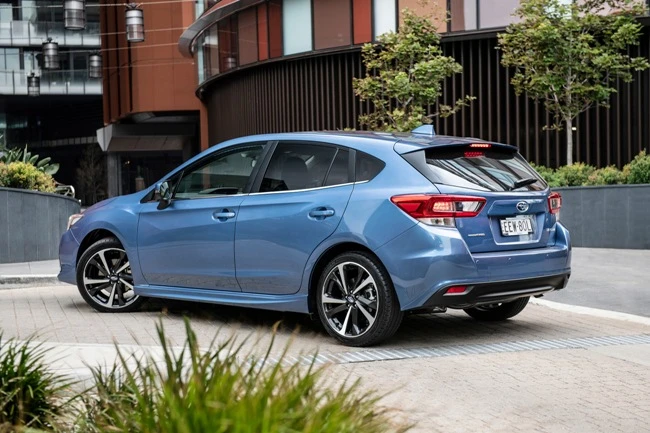
The range remains as a four tier model. The entry level 2.0i model starts from $23,740 and $23,940 for sedan and hatch, whilst the 2.0i-L starts from $25,860 and $26,090. The 2.0i-Premium is $28,390 and $28,590 with the range topper 2.0i-S at $31,160 and $31,360. Again these are manufacturer’s list prices.
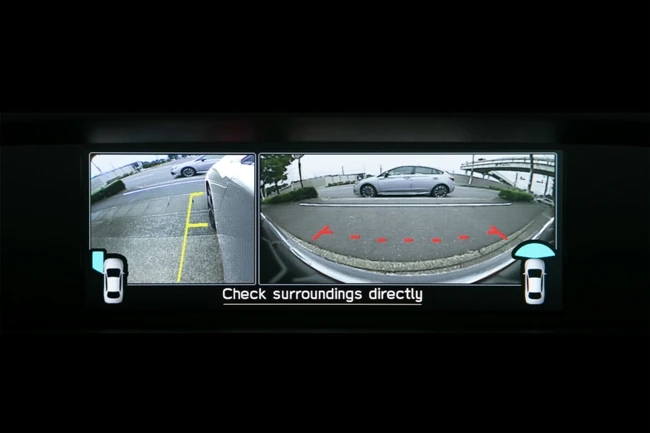
Apart from the looks there has been tweaks underneath for a better ride and handling package. Premium receives Blind Spot Monitor, Lane Change Assist, Rear Cross Traffic Alert plus Reverse Automatic Braking and Front View Monitor. The S gains front and side camera monitors, along with an auto dipping passenger side mirror when reversing.
All cars have a standard five year and unlimited kilometre warranty. Contact Subaru to book a test drive.
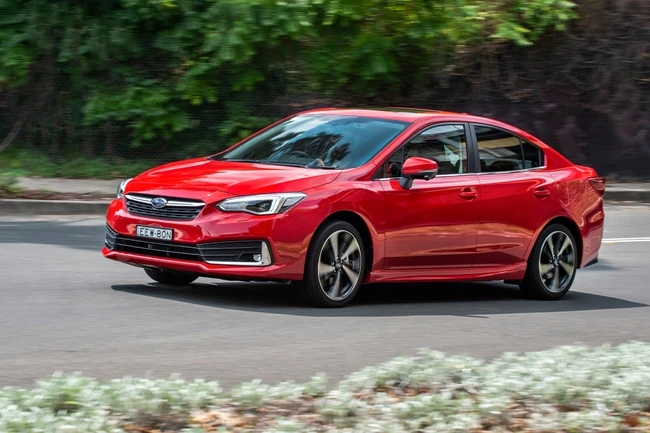
EV vs Hydrogen Vehicle

Electric vehicles are becoming more widely available, and better at what they offer. But potential consumers of EVs have a checked enthusiasm towards going out and buying one; and for good reason. The main inquiries lie around how pricey a new EV is to purchase, their fire risk, crash safety risk, their range between top ups being rather poor and subsequent charging times way too long, the lack of charging stations, as well as their candid hidden impact on our environment which is actually very big.
EVs require big, powerful rechargeable batteries that use lead–acid (“flooded”, deep-cycle, and VRLA), NiCd, nickel–metal hydride, lithium-ion, Li-ion polymer, and, less commonly, zinc–air, sodium nickel chloride in their design. It is worth noting that these expensive EV batteries require a bigger carbon footprint in their production and use a finite resource to make them. Then there is the environmental cost of battery disposal when the spent battery needs replacing. So, are we any better off driving EVs? The answer would have to be no.
Actually, no vehicle driven on our road can be classed as purely “green” or “environmentally friendly” for people and their environment. The fact is whatever car we choose, buy and drive; it will have some ecological impact. Perhaps the best way of describing this would be that all vehicles impact on our environment and pollute, while other vehicles do so a lot more, and then some do so a bit less. It is quite false to suggest that EVs are environmentally friendly.

That brings me to the question: What is the most environmentally friendly vehicle? There are some major car manufacturers that are pushing forward with hydrogen power. A hydrogen driven car is powered by a hydrogen fuel cell that produces the electricity that the electric car engines need. Hydrogen vehicles only take five minutes to top-up, and provide much better range. The only emissions are water, because inside the fuel cell hydrogen reacts with oxygen to produce water as a discharge. So, hydrogen vehicles don’t emit pollutants. Hydrogen can be produced from fossil fuels and natural gas, but it can also be produced from renewable energy sources by way of electrolysis.
I think hydrogen is the best way forward, and the Hyundai Nexo is the first vehicle to arrive in Australia that’s available for the Australian government and business fleets to use. The reason for its limited availability is simply because Australia doesn’t have an organised hydrogen refuel station network set up, as yet. But I can see this changing to it becoming common place on all fuel station forecourts across Australia.
Hyundai, Toyota and BMW are some of the key hydrogen vehicle designers and manufacturers.
Kia Confirms Stylish Sorento For 2020.
Kia has confirmed the rumours of what its forthcoming Sorento will look like prior to its first public appearance at the 2020 Geneva International Motor Show. Not unexpectedly, it features styling cues first flagged in the Seltos. There has been subtle changes to the styling, such as the change to the front and rear overhangs. These have been reduced with the result being the Sorento now looks longer in profile.  The front end has strong relationships with the Seltos, including the restyled headlight cluster with Kia saying it has “Tiger Eye” LED running lights. These are said to mimic the lines around the eyes of a tiger. A longer bonnet and a push-back of the windscreen’s A-pillar by 30mm adds to that perception of length. The rear edges of the bonnet wrap around further into the uppermost edges of the front guards, and create the start of a character line that helps draw the eyes from front to rear. This takes the view to the completely new rear lights, in a stunning vertyical block design, rather than the previous broadsheet styling horizontally, and there’s a hint of Volvo’s SUV here. There’s also the Seltos relationship to be found here, with the rear passenger window having the fin reaching towards the roof as seen in the smaller car.
The front end has strong relationships with the Seltos, including the restyled headlight cluster with Kia saying it has “Tiger Eye” LED running lights. These are said to mimic the lines around the eyes of a tiger. A longer bonnet and a push-back of the windscreen’s A-pillar by 30mm adds to that perception of length. The rear edges of the bonnet wrap around further into the uppermost edges of the front guards, and create the start of a character line that helps draw the eyes from front to rear. This takes the view to the completely new rear lights, in a stunning vertyical block design, rather than the previous broadsheet styling horizontally, and there’s a hint of Volvo’s SUV here. There’s also the Seltos relationship to be found here, with the rear passenger window having the fin reaching towards the roof as seen in the smaller car. Passengers are given more in the way of sophistication and comfort. Trim levels have improved with metallic tones, higher grade materials, and wood-effect cladding. A new 10.25 inch touchscreen becomes the centrepiece of the tech level inside the Sorento. That complements the brand new 1203 inch full colour and high definition driver’s information screen. Along with other tech, the forthcoming Sorento is easily the most technologically advanced Sorento offered yet.
Passengers are given more in the way of sophistication and comfort. Trim levels have improved with metallic tones, higher grade materials, and wood-effect cladding. A new 10.25 inch touchscreen becomes the centrepiece of the tech level inside the Sorento. That complements the brand new 1203 inch full colour and high definition driver’s information screen. Along with other tech, the forthcoming Sorento is easily the most technologically advanced Sorento offered yet. The cabin is spacious, and has an ambience highlighted by LED mood lighting. The front air vents have an uncanny resemblance to the tail lights of the revered Holden HR. Switchgear takes Kia’s ergonomics to an even higher level, with a balanced look and spacing.
The cabin is spacious, and has an ambience highlighted by LED mood lighting. The front air vents have an uncanny resemblance to the tail lights of the revered Holden HR. Switchgear takes Kia’s ergonomics to an even higher level, with a balanced look and spacing. The 2020 Sorento will be officially unveiled on March 3.
The 2020 Sorento will be officially unveiled on March 3.